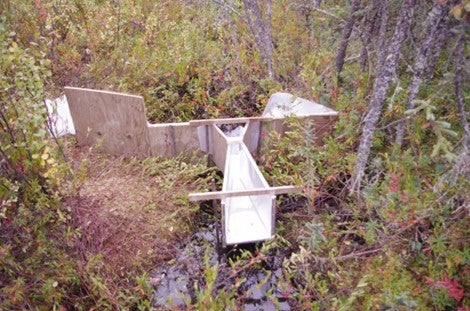By: Alexandre Lhosmot
Big changes are happening in Canada's Arctic region because of climate change. The ground that used to be permanently frozen (called permafrost) is thawing at an increasing rate. This accelerated thaw has significant consequences for the landscape, affecting the stability of infrastructure and the functioning of aquatic and terrestrial ecosystems. The latter includes changing the movement of water and carbon between the land and the atmosphere, with global implications.
Understanding the Changes
To understand these landscape changes, we focus on the watershed, the area of land that drains water to a common point. Hydrological processes are important because they are closely linked to ecosystem composition, structure, function and services. However, the hydrological water balance (the difference between water leaving and entering the system) of small basins in permafrost regions is a significant knowledge gap. This research is also important for understanding and establishing the carbon balance of these ecosystems.

Research infrastructure (“flume box”) used to measure the quantity of water exported from a sub-basin area. Credit: Oliver Sonnentag
This study is one component of the larger Can-Peat project, which aims at understanding how climate change affects peatland carbon stocks and informs the management of peatlands as nature-based solutions. Our focus is on how thawing permafrost will impact the health of peatlands. Our research will provide valuable insights into how peatlands – as significant global carbon reservoirs – will respond to climate change.
Our study site
We are studying the Scotty Creek research basin, located in the Taiga Plains ecozone near the southern limit of permafrost in the Northwest Territories. The area is made up of a boreal peatland complex dominated by a combination of forest-covered permafrost peat plateaus and open permafrost-free wetlands that have resulted from the collapse of peat plateaus. Channel fens connect the wetlands to the drainage system. The rich data archive of Scotty Creek comprises long-term monitoring environmental data on permafrost conditions, land cover change, and hydrological, meteorological, and vegetation measurements.
Early Findings
We have computed a three-year (2014-2016) water balance for three small sub-basins (<0.3 km²) located in the headwaters of the Scotty Creek research basin. We also created a long-term annual water balance for the basin (130-202 km²) from 1996 to 2022. Here are some early insights that may be of interest to the scientific community:
- Different methods (e.g., digital elevation model-derived or field observations) lead to different watershed boundaries in relatively flat and rapidly changing boreal peatland complexes. Researchers therefore need to be careful when interpreting hydrological processes. For instance, permafrost peat plateaus can create barriers that isolate some areas from the drainage surface.
- Evapotranspiration, primarily dominated by evaporation in this context, is the major water flux leaving the peatland complex, exceeding the amount of surface water runoff.
- The long-term hydrological analysis reveals important changes in annual surface runoff, most likely due to changes in landscape caused by permafrost thawing, rather than precipitation changes. This raises questions about how water runoff and storage will evolve in the coming decades.
These insights motivate us tocontinue long-term monitoring efforts that explore water, vegetation and carbon. Long-term monitoring will allow us to observe trends, detect changes in the landscape evolution, and understand the processes involved.

The landscape and some research infrastructures at the headwaters of the Scotty Creek research basin. Open wetlands and forest-covered peat plateaus are distinguishable. The research infrastructures are two eddy covariance towers measuring greenhouse gas exchanges (CO2, CH4, H2O) between the ecosystems and the atmosphere. The largest tower measures flux at the entire ecosystem scale, integrating forests and open areas. The smaller tower, nested in the footprint of the larger tower, is measuring fluxes for the open wetlands only. Credit: Mason Dominico
What’s next?
Is a thawing boreal peatland complex a net source or sink of carbon, once vertical and lateral fluxes are considered? From here, our team is working on building the Net Ecosystem Carbon Balance (NECB) of this thawing boreal peatland complex. This work is based on our hydrological analysis and aims to determine whether these ecosystems reduce or increase greenhouse gases in the atmosphere and their related effects on climate.
In addition, the site experienced a fire in October 2022. The instruments, i.e. eddy-covariance tower, were rebuilt identically after the fire. We have a unique opportunity here to quantify the interacting and cascading consequences of a permafrost thaw and a late season wildfire on surface-atmosphere interactions, carbon cycle processes, and their hydrological controls.
Implications of our research
We expect this work will be of interest to several audiences, including
- Other peatland or boreal researchers will be interested in our efforts to understand and quantify the water and carbon balances of these complicated systems, at different spatial scales and for wet and dry meteorological years.
- National and international governments and climate researchers may be interested in how our data can help them improve the accuracy of global water and carbon models.
- Local communities and governments will find value in how increased hydrological understanding of peatland complexes can inform wildlife and aquatic habitat decision making.
The following researchers are part of our team:
Alexandre Lhosmot1, Gabriel Hould Gosselin1,2, Manuel Helbig1,3, Julien Fouché1,4, Youngryel Ryu5 Matteo Detto6, Jonathan A. Wang7, Ryan Connon8, William Quinton9, Tim Moore10 and Oliver Sonnentag1
1Département de géographie, Université de Montréal, Montréal, QC, Canada
2Department of Geography and Environmental Sciences, Northumbria University, Newcastle upon Tyne, UK
3Department of Physics & Atmospheric Science, Dalhousie University, Halifax, NS, Canada
4LISAH, Université de Montpellier, INRAE, IRD, Institut Agro, AgroParisTech, Montpellier, France
5Department of Landscape Architecture and Rural Systems Engineering, Seoul National University, Seoul, South Korea
6Department of Ecology and Evolutionary Biology, Princeton University, Princeton, NJ, USA
7School of Biological Sciences, University of Utah, Salt Lake, UT, USA
8Environment and Climate Change, Government of the Northwest Territories, Yellowknife, NT, Canada
9Cold Regions Research Centre, Wilfrid Laurier University, Waterloo, ON, Canada
10Department of Geography, McGill University, Montréal, QC, Canada